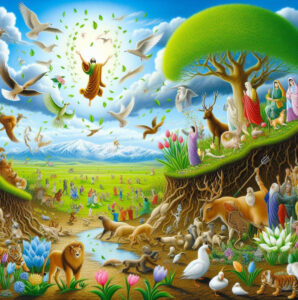Reviving the Dry Bones: A Prophetic Vision of Spiritual Renewal
 by Pastor/Dr Wesley Swift
by Pastor/Dr Wesley Swift
“Can These Bones Live?” by Dr. Wesley A. Swift do not directly cite specific verses from the Bible. However, the content of the quotes reflects themes and concepts found in various biblical passages. Here are some relevant verses that align with the ideas presented in the quotes:
1. “Can These Bones Live?” – This phrase alludes to Ezekiel 37:3-6, where the prophet Ezekiel is brought to a valley of dry bones by the Spirit of the Lord and asked if these bones can live. Through the power of God, the bones are brought back to life, symbolizing the restoration of Israel.
2. “Not live by bread alone. But by every word out of the mouth of God” – This is a reference to Matthew 4:4, where Jesus quotes Deuteronomy 8:3, emphasizing the importance of spiritual nourishment and obedience to God’s Word.
3. “Ye shall live” – This phrase echoes Ezekiel 37:5, where God promises to bring life back to the dry bones in the valley, representing the restoration and revival of Israel.
4. “For out of Zion shall go forth the law, and the Word of the Lord from Jerusalem” – This quote is from Isaiah 2:3, envisioning a future where God’s law and Word will be established from Zion, symbolizing divine authority and guidance.
While the specific verses are not directly cited in the quotes provided, the themes and messages align with the broader biblical narrative and teachings found in the Scriptures.
1. “The bones started to come together, then sinew came, then flesh.” – This description aligns with Ezekiel 37:7-8, where Ezekiel witnesses the bones coming together, covered with sinews, flesh, and skin, symbolizing the restoration and revival of the nation of Israel.
2. “Almighty YAHWEH raise this host.” – This echoes Ezekiel 37:10, where God commands Ezekiel to prophesy to the breath, calling for the breath to enter the slain, so they may live and stand on their feet as a vast army.
3. “In the name of the Almighty YAHWEH, we call for the winds of the spirit from the east to the west, from the north to the south, to blow on these bones.” – This invocation reflects the imagery of the four winds in Ezekiel 37:9, symbolizing the breath of life that brings restoration and vitality to the dry bones.
4. “Then I will be like a wall of fire about you.” – This phrase is reminiscent of Zechariah 2:5, where God promises to be a wall of fire around Jerusalem, providing divine protection and security for His people.
While the quotes do not directly cite specific verses, the themes and language used by Dr. Wesley A. Swift in “Can These Bones Live?” are deeply rooted in the prophetic imagery and messages found throughout the book of Ezekiel and other parts of the Bible.
Summary
“Can These Bones Live?” by Dr. Wesley A. Swift delves into the prophetic vision of Ezekiel, particularly focusing on the symbolic significance of the dry bones coming back to life. Dr. Swift interprets this vision as a representation of the restoration and revival of the whole House of Israel. The text emphasizes the spiritual awakening and empowerment of God’s people, highlighting the role of divine intervention in bringing life to that which was once dead.
The narrative unfolds with Ezekiel standing in a valley filled with dry bones, symbolizing the state of spiritual desolation and decay. Through the power of God, the bones start to come together, covered with sinews, flesh, and skin, signifying a miraculous transformation from death to life. This imagery reflects the promise of God to breathe new life into His people and restore them to their rightful place.
Dr. Swift draws parallels between Ezekiel’s vision and the contemporary world, suggesting that the dry bones represent not just physical death but also spiritual stagnation and captivity. The call for the winds of the spirit from all directions signifies the universal reach of God’s power and the renewal it brings to His chosen ones. The text underscores the importance of faith, prophecy, and divine intervention in the process of revival and restoration.
Furthermore, Dr. Swift explores the concept of the whole House of Israel, emphasizing that the restoration is not limited to a specific tribe but encompasses the entirety of God’s chosen people. This inclusive vision speaks to the unity and collective destiny of Israel under the divine guidance of YAHWEH. The text underscores the interconnectedness of prophecy, history, and spiritual renewal in shaping the destiny of God’s people.
Moreover, the narrative touches upon the themes of captivity, redemption, and the fulfillment of God’s promises. The symbolic imagery of bones coming back to life serves as a powerful metaphor for the resurrection of Israel from a state of exile and spiritual death. Dr. Swift’s interpretation highlights the cyclical nature of prophecy and the timeless relevance of God’s word in guiding His people through times of trial and tribulation.
In conclusion, “Can These Bones Live?” offers a profound reflection on the enduring message of hope, restoration, and divine intervention found in the prophetic vision of Ezekiel. Dr. Wesley A. Swift’s insightful interpretation sheds light on the spiritual significance of the dry bones coming back to life, emphasizing the transformative power of God’s word and the promise of renewal for His people. The text serves as a reminder of the eternal truths embedded in biblical prophecy and the enduring faithfulness of God in bringing life to that which was once dead.